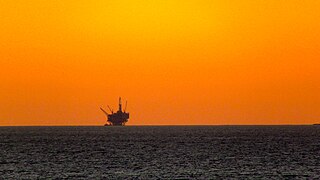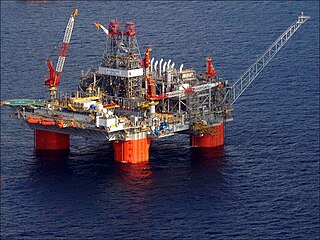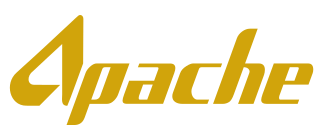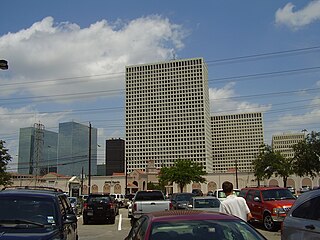
An oil platform, offshore platform, or offshore drilling rig is a large structure with facilities for well drilling to explore, extract, store, and process petroleum and natural gas which lies in rock formations beneath the seabed. In many cases, the platform contains facilities to house the workforce as well.

The Atlantis oil field is the third largest oil field in the Gulf of Mexico. The field was discovered in 1998 and is located at the Green Canyon blocks 699, 700, 742, 743, and 744 in United States federal waters in the Gulf of Mexico about 130 miles (210 km) from the coast of Louisiana. The oil field lies in water depths ranging from 4,400 to 7,100 feet. The subsea structure of Atlantis has long been the target of safety critics.

Thunder Horse oil field is a large offshore deepwater oil field in the Gulf of Mexico, around 150 miles (240 km) southeast of New Orleans, Louisiana. Large new oil discoveries within it were announced in early 2019.

Mars is a permanent offshore drilling and production tension-leg oil platform (TLP) operating in Mississippi Canyon blocks 762, 763, 806, 807, 850 and 851 in the Gulf of Mexico and was approved by the MMS in December 1992 with production beginning on July 8, 1996. The leases were acquired by Shell in 1985 and 1988. The platform is a joint venture between Shell Oil Company and BP, with Shell owning the majority share and operating the facility.

Apache Corporation is a company engaged in hydrocarbon exploration. It is organized in Delaware and headquartered in Houston. The company is ranked 438th on the Fortune 500.

Mad Dog Oil Field is an offshore oil field located along the Sigsbee Escarpment at Green Canyon blocks 825, 826 and 782, Western Atwater Foldbelt, Gulf of Mexico. The field is located about 190 miles (310 km) south of New Orleans and 150 miles (240 km) southwest of Venice, Louisiana, United States. It is in the depth of 5,000 to 7,000 feet of water.

Offshore drilling is a mechanical process where a wellbore is drilled below the seabed. It is typically carried out in order to explore for and subsequently extract petroleum which lies in rock formations beneath the seabed. Most commonly, the term is used to describe drilling activities on the continental shelf, though the term can also be applied to drilling in lakes, inshore waters and inland seas.

Canada's early petroleum discoveries took place near population centres or along lines of penetration into the frontier.
Deepwater Millennium is a fifth generation Samsung/Reading & Bates designed, dynamic positioned (DP) Marshall Islands-flagged drillship owned by Transocean. The vessel is capable of drilling in water depths up to 8,100 ft using an 18.75 in (47.6 cm), 15,000 psi blowout preventer (BOP), and a 21 in (53 cm) outside diameter (OD) marine riser.

Green Canyon is an area in the Gulf of Mexico that is rich in oil fields and under the control of the Bureau of Ocean Energy Management. Among other oil fields Green Canyon consist of Atlantis operated by BP, Marco Polo and K2 operated by Anadarko Petroleum, Manatee operated by Shell, Shenzi operated by BHP Billiton, Droshky operated by Marathon Oil, Tahiti operated by Chevron Corporation.
Deepwater drilling, or Deep well drilling, is the process of creating holes by drilling rig for oil mining in deep sea. There are approximately 3400 deepwater wells in the Gulf of Mexico with depths greater than 150 meters.

The U.S. offshore drilling debate is an ongoing debate in the United States on whether or not, the extent to which, in which areas, and under what conditions, further offshore drilling should be allowed in U.S.-administered waters.

The Tiber Oil Field is a deepwater offshore oil field located in the Keathley Canyon block 102 of the United States sector of the Gulf of Mexico. The deepwater field was discovered in September 2009 and it is operated by BP. Described as a "giant" find, it is estimated to contain 4 to 6 billion barrels of oil in place. Although BP states it is too early to be sure of the size – a "huge" field is usually considered to contain 250 million barrels. It required the drilling of a 10,685 m (35,056 ft) deep well under 1,260 m (4,130 ft) of water, making it one of the deepest wells ever drilled at the time of discovery.
Offshore oil and gas in the Gulf of Mexico is a major source of oil and natural gas in the United States. The western and central Gulf of Mexico, which includes offshore Texas, Louisiana, Mississippi, and Alabama, is one of the major petroleum-producing areas of the United States. Oil production from US federal waters in the Gulf of Mexico reached an all-time annual high of 1.65 million barrels per day in 2017. Oil production is expected to continue the upward trend in 2018 and 2019, based on ten new oil fields which are planned to start production in those years. According to the Energy Information Administration, "Gulf of Mexico federal offshore oil production accounts for 17% of total U.S. crude oil production and federal offshore natural gas production in the Gulf accounts for 5% of total U.S. dry production."

The Macondo Prospect is an oil and gas prospect in the United States Exclusive Economic Zone of the Gulf of Mexico, off the coast of Louisiana. The prospect was the site of the Deepwater Horizon drilling rig explosion in April 2010 that led to a major oil spill in the region.

The Deepwater Horizon drilling rig explosion was the April 20, 2010, explosion and subsequent fire on the Deepwater Horizon semi-submersible Mobile Offshore Drilling Unit (MODU), which was owned and operated by Transocean and drilling for BP in the Macondo Prospect oil field about 40 miles (60 km) southeast off the Louisiana coast. The explosion and subsequent fire resulted in the sinking of the Deepwater Horizon and the deaths of 11 workers; 17 others were injured. The same blowout that caused the explosion also caused a massive offshore oil spill in the Gulf of Mexico, considered the largest accidental marine oil spill in the world, and the largest environmental disaster in U.S. history.












